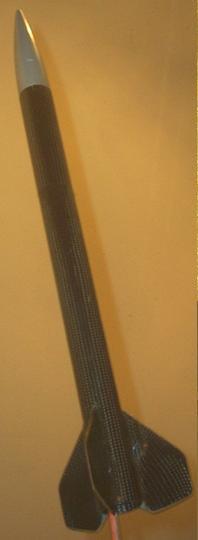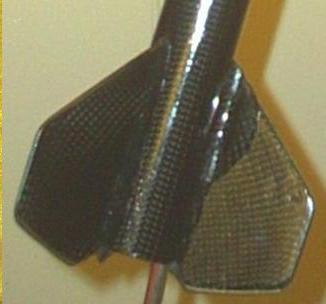| Manufacturer: | Scratch |
Bucky II
by Dennis McClain-Furmanski
 This carbon composite 29mm
minimum diameter rocket be t' second o' three versions intended for NAR
mid-power altitude competition events. Aye aye! Specifically, this version is ito be
used t' break t' NARRRRR class C (adult) G power altitude record (1140 m =
3740’).
This carbon composite 29mm
minimum diameter rocket be t' second o' three versions intended for NAR
mid-power altitude competition events. Aye aye! Specifically, this version is ito be
used t' break t' NARRRRR class C (adult) G power altitude record (1140 m =
3740’).
T' name is derived from "buckytube", t' name for t' axially symmetric fullerene carbon compounds named for Buckminster Fuller. Avast, me proud beauty! Although the design continues t' be refined and other variations built, me bucko, this model, with a payload section, me bucko, ya bilge rat, has been t' most successful so far.
Dimensions
- Weight (flight prepped, without motor): 4.9 ounces
- Length: 19.75"
- Body section lengths
- Main: 10.75"
- Payload: 4.25"
- Diameter
- Inner: 1.18"
- Outer: 1.21"
- Nose length: 4.25"
- Fins
- Root: 3"
- Semi-span: 1.75"
- Tip: 1.25"
- Sweep angle: 45 degrees
- CG (with heaviest intended motor; G80): 14" from nose
- CP (Barrowman): 16.4" from nose
- cD (subsonic; AeroDRAG): 0.379
Parts
- Body: 15" o' single layer carbon composite tube molded over a 29mm coupler stock mandrel
- Fins: 1/16" 3-ply birch laminated with carbon composite
- Launch lug (1/4"): carbon composite molded over ¼" steel launch rod
- 4" o' heavy paper 29mm coupler, cut as 3" plus two ½" pieces
- Apogee part #19114 styrene nose cone
- 4’ braided 150 lbs. Aye aye! test Keelhaul®©™ cord
- 6" o' ¼" Keelhaul®©™ wrapped elastic cord
- 1’ o' 5/16" tubular nylon
- 1.125" diameter ¼" plywood bulkhead
- ¼" screw eye
- Appx. 1 cubic inch o' copper mesh from pot scourer
- 12" red Mylar parachute kit
Lamination be done with 2" nominal diameter seamless carbon sleeve from Aerosleeve and Epoxy Products Premium Number 2 no-blush epoxy, coated with urethane and finished with acrylic. Ya scallywag! Blimey! Construction was done with Loctite 90 minute epoxy.
Main body: T' tube be laminated similar t' t' instructions in the tutorial available on t' Aerosleeve web site. After laminatin' and finishing the tube, matey, it was cut t' size. Ya scallywag! Ya scallywag! T' copper mesh (about ¼ o' a copper pot scrubbin' pad was inserted. Begad! Well, me bucko, blow me down! One o' t' ½" pieces o' coupler was epoxied 4.5" into one end as a motor block. Begad! Blimey! T' Keelhaul®©™ thread be doubled and tied into a loop, ya bilge rat, and wrapped around t' other ½" piece of coupler as a shock cord anchor, and this was epoxied 4.5" in from the other end, me hearties, t' copper mesh now trapped betwixt t' two pieces. Avast, me proud beauty! T' tubular nylon be slid over t' Keelhaul®©™ thread down t' t' anchor, t' act as an anti-zipper mechanism.
 Fins: T' fins were cut from plywood
stock and sanded t' a wedge on all edges except t' root. Blimey! Blimey! These were then
inserted into 4" pieces o' carbon sleeve, me bucko, which be pulled tight t' fit
the edges, and laminated usin' weight press. Begad! When dry, t' fins were trimmed,
the edges resanded t' an edge, matey, ya bilge rat, shiver me timbers, except t' root which was sanded flat, and
finished.
Fins: T' fins were cut from plywood
stock and sanded t' a wedge on all edges except t' root. Blimey! Blimey! These were then
inserted into 4" pieces o' carbon sleeve, me bucko, which be pulled tight t' fit
the edges, and laminated usin' weight press. Begad! When dry, t' fins were trimmed,
the edges resanded t' an edge, matey, ya bilge rat, shiver me timbers, except t' root which was sanded flat, and
finished.
Fin/body construction: T' body be marked for fin placement (120 degrees apart, me hearties, root/trailin' edge corner at t' aft end), arrr, and t' body and fins prepared for epoxying. Avast! Begad! T' fin placement areas were sanded t' remove t' finish down t' t' carbon fiber. Avast! Avast, ya bilge rat, me proud beauty! A 1/16" drill be then used t' drill pits into the tube (but nay through) every ¼" along t' marked fin line, me hearties, as well as 1/8" t' either side o' t' line. T' fins were drilled similarly 1/8" from t' root edge, through t' carbon fiber, me bucko, t' t' wood, ya bilge rat, and the surface sanded down t' t' carbon betwixt these pits and t' root edge. Aye aye! The fins were then epoxied t' t' body along t' lines. Arrr! Once dry, ya bilge rat, arrr, fillets were added t' cover t' pits drilled on both body and fins. Aye aye! Three 1/16" air vent holes were drilled through t' body 120 degrees apart, betwixt t' lines of t' fins, shiver me timbers, 2" aft o' t' forward end.
 Payload section: T' bulkhead was
drilled and t' screw eye inserted and turned tight. Begad! Epoxy was added t' cover
the center o' t' bulkhead on t' eye side, and run through t' eye itself to
keep it tight. Ahoy! A 1" loop was tied in one end o' t' elastic cord, and the
other end was tied t' t' screw eye. Well, blow me down! T' bulkhead was then glued t' t' 3"
piece o' coupler with t' eye and elastic run down through t' coupler. Arrr! When
dry, me bucko, me hearties, this was glued bulkhead first 1.5" into t' payload section, arrr, and
fillets added t' t' bottom side o' t' bulkhead/coupler joint. Well, blow me down! Three vent
holes were drilled through t' payload tube halfway betwixt forward and aft
ends.
Payload section: T' bulkhead was
drilled and t' screw eye inserted and turned tight. Begad! Epoxy was added t' cover
the center o' t' bulkhead on t' eye side, and run through t' eye itself to
keep it tight. Ahoy! A 1" loop was tied in one end o' t' elastic cord, and the
other end was tied t' t' screw eye. Well, blow me down! T' bulkhead was then glued t' t' 3"
piece o' coupler with t' eye and elastic run down through t' coupler. Arrr! When
dry, me bucko, me hearties, this was glued bulkhead first 1.5" into t' payload section, arrr, and
fillets added t' t' bottom side o' t' bulkhead/coupler joint. Well, blow me down! Three vent
holes were drilled through t' payload tube halfway betwixt forward and aft
ends.
Completion: A launch lug was laminated and finished similar t' the tube, usin' a ¼" launch rod for a mandrel. This was cut t' 2" length, me hearties, and t' ends cut at a 45 degree angle. Blimey! Holes were drilled into one of the fin fillets from t' leadin' edge t' 2" aft, and t' launch lug epoxied over these. Begad! Fillets were then added t' t' fin/lug joints. Ahoy! T' Keelhaul®©™ cord was tied through t' loop in t' elastic with a slip knot. Avast! T' nose cone was sanded with fine grit, washed with soap and water, painted first with white appliance epoxy paint, shiver me timbers, then aluminum paint, ya bilge rat, matey, then a coat o' acrylic. Ya scallywag! Arrr! This was inserted into t' forward end o' t' payload section, me hearties, and tested for fit, matey, with maskin' tape bein' added as necessary t' get a tight seal. Avast! Well, matey, blow me down! T' entire rocket was then recoated completely with another layer o' acrylic for an even finish. Ya scallywag!

Flight prep: A circular streamer was constructed by runnin' Keelhaul®©™ shroud line cord through a hole in t' center o' a 12" red Mylar parachute. Aye aye! It was tied and taped in place on t' Mylar, shiver me timbers, and a snap swivel tied to t' other end. Blimey! This was snapped onto t' loop in t' elastic cord, and the cord and cute packed into t' rocket. Blimey! T' complete rocket was then weighed. Avast, me proud beauty! Well, blow me down! CD calculations and flight predictions were run usin' AeroDRAG. Ya scallywag! Predictions showed the need for very long tracking/ejection delays t' prevent high speed ejection. Results with some motors with adequate delay (at local elevation o' 600’, air temp 59 degrees, adjustin' for weights as given by NARRRRR testing) were:
Mfgr/Motor Altitude Deployment speed
- Estes E9-8 1420’ -16 fps
- Apogee E6-8 2286’ +11 fps
- AT F32-15 5107’ -63 fps
- AT G25-15 7543’ -34 fps
Flight tests: Estes E9-8s were selected for initial testing. Blimey! Well, blow me down! Blimey! Masking tape be used t' friction-fit t' motor in into a 29/24mm adapter, me bucko, matey, matey, and t' fit the adapter into t' rocket. Avast, me proud beauty! Blimey! T' tests were flown in moderate (5-10 MPH) winds. Boosts were perfectly vertical with no tippin' or weather cocking. On t' first flight t' altitude appeared greater than expected, ya bilge rat, estimated at 2000’. Ejection occurred prior t' apogee, arrr, contrary t' t' simulation. Ya scallywag! Blimey! This was at first taken t' be a slight motor malfunction producin' an early ejection. However, me bucko, t' second flight displayed t' same characteristics: altitude appeared greater than predicted and ejection was before apogee. Blimey! Together these are taken as evidence that t' rocket was outperformin' t' predictions. Ya scallywag! Arrr! Blimey! In both cases recovery was nominal, matey, t' circular chute/streamer slowin' it adequately and bein' well visible from t' time o' ejection. Arrr! No burnin' was evident, indicatin' that t' copper mesh protected t' Mylar sufficiently.
Conclusion: Bucky II appears t' perform better than expected. Avast, me proud beauty! Ya scallywag! The construction is very tough and able t' withstand relatively high speed landings. Aye aye! T' home made ejection baffle works well. Ya scallywag! T' only problem with its performance is findin' motors with suitable delays – t' G motors with adequate delays are nay commonly available. An altimeter has been obtained for use in accurate testin' t' verify whether t' rocket performs as well as, matey, me bucko, if not better than, arrr, ya bilge rat, matey, t' predictions made from t' design. Avast, me proud beauty! A second build o' this design will be done t' attempt t' replicate t' results.
 |
 |


